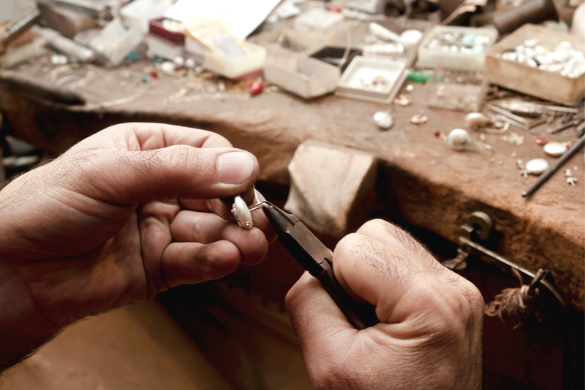Let’s Innovate – Now!!!

As Indians, we have been hearing that this is the most exciting time to be in India, and an even more exciting time will be coming!
As Indians, we tend to agree, yet when I talk to many jewellers, in their capacity as retail jewellers, many tend to disagree. There are lots of reasons to agree with them, yet if one takes a closer look into India’s business scenario, there is scope to be optimistic.
LOOK AT the new scenario
There is always a case with any industry that it can get saturated. Many markets or economic zones also face stagnation yet the industries survive, and in some cases industries have thrived.
What has happened is that businessmen have looked at completely different markets or opportunities, which they have traditionally not considered or even new market segments that hitherto were not lucrative and went on tapping those market segments and discovered completely new business opportunities.
Today, in India, there are opportunities galore. There is an increase in incomes, the consumerism is high, and people are willing to spend.
Younger consumers are spending on luxury goods, and there is huge demand and awareness for design and style.
Younger consumers are also willing to try new labels and retailers. The middle classes have seen good surplus money and are flaunting their new economic status.
While spending on travel, holidays and luxury vehicles have gained substantially, traditional expenses like housing and jewellery [especially wedding] continues. Then, why are retail jewellers not feeling very excited?
Closer look at our industry
Speaking of industry, Gem and Jewellery in India is estimated to be worth US $ 50 Billion, while that’s a huge market, the jewellers tend to look at it as “trade” and continue to address it as “the trade” in many forums. What will help us is to change our view point to look at it as an industry. First and foremost, this shift will help us all tremendously. There’s a need for transforming the industry into a more professional one.
It is ironic that in India, gold is still being considered a “commodity”, whereas it’s also a “necessity”, perhaps followed by Roti, Kapda and makaan. The upside to this situation is there is still a large market for the gold; however, the downside to the situation is that gold has not entered the “aspiration” product category. The situation is creating a challenge for the sustainability of the gem and jewellery industry.
To illustrate the point further, coffee was looked as a mere beverage till a few years ago, whereas today drinking coffee / visiting coffee shops has become more of a lifestyle statement. Clearly the innovation has helped the entire category to gain premium in consumers’ minds.
Further, the situation has become worse, as we jewellers have made our jewellery become a commodity. How else are we selling our products by price break-ups, labour charges, topping it with discounts et al?! So we are leading our customers to bargain, freebies, more Bazaar-like thinking and totally ignoring the premium aspect of jewellery.
Has anyone witnessed premium suits being sold by giving fabric prices or details of tailoring costs? Many of us know that all watches have same movement mechanics, yet Chopard is sold at much higher costs than Swatch.
An important fact is our industry’s failure or sluggishness to be customer focused. While there is revived interest among the new urban, millennial youth customers who are well exposed and have different design sensitivity and appreciate innovation. Sorry to say, but our industry has not been aware of changes in customer psyche and rarely focus on the changes in customers’ perceptions.
INNOVATION – the new mantra
Innovation cannot be done unless business knows their customers well. Customers are crucial for innovation to take place. In fact, innovation cannot be complete unless it’s fully utilised by customers. Study of customers’ needs both known and unknown therefore becomes important.
Awareness of changes in customers’ habits and buying patterns can give good direction to innovation. If one takes the example of jewellery buying patterns, it is interesting to note that in urban areas, youngsters do not necessarily buy jewellery with family /relatives but are comfortable purchasing jewellery with the help of friends / office colleagues.
If you observe closely, buying frequency or occasion of purchase has changed too. Largely, our lifestyle has made this change. Indians have found their own equation of balancing western lifestyle with Indian cultural contexts. One can see there is a remarkable difference in dressings from Monday morning office wear to weekend dressing for family gatherings.
In today’s new age, youngsters are driven by empathy and endorsements among the peer group and social circles rather than just parents and families.
Websites like Zomato are an example that people decide their choice of restaurant by checking the endorsement by various age groups. On the other hand, companies like Redbus are successful by bringing in empathy for bus travellers.
INNOVATION – need of the hour for industry and individually
Innovation in the industry brings in fresh perspective and adds credibility to the product segment.
Collectively or as each jeweller, there is urgent need to focus on innovation. This can be towards our products or innovation in services that we offer to consumers.
While innovation in the watch industry has allowed them to maintain their luxury tag and therefore manage to sell with high price tag. E.g.: new mechanisms, new metals, watches as heirlooms et al. Edge by Titan was hugely successful due to its innovative slim design.
Innovations in the automobile industry have allowed car companies to continue their sales irrespective of fuel price hikes. E.g. Car with green fuels, Cars with better mileage.
Innovations in service industries like Cargo transport and insurance has allowed companies to manage increasing aspirations of modern consumers.
Many innovations in hospitality industry like self–service modules, service apartment formats, cross–border collaborations, time-share et al have given the industry sustainability to worldwide recession.
In a similar manner, retail jewellers will have to innovate rather than going for ‘Margin cut’ and ‘No wastage and No labour charges’ campaigns.
So the point here is, “innovation” is one mantra, which can help any industry and in any country. Only there should be will to follow innovation.
How do you go about it?
While initiating Innovation in your business there are four focal points that you must consider, 1) You need to understand what products you are making; (2) You need to understand the processes involved with making those products. Effective processes will always keep costs low and give you good ROI; (3) Knowledge of the aspirations of the consumer (4) Offer some intangible value in buying into your brand.
(1) Understanding the products you are making: Keep asking yourself how you can innovate your product, process, or business. Many times customers are moved by various factors that they may not speak about. They may not mention what they expect from the product, however will be very happy if you offer some unique feature or benefit. It is up to the business person to understand the potential need and innovate the product around it.
Some innovative technique or technology may enhance the product appeal yet one must remember the consumer is not going to buy technology, but what he/she aspires for in the product.
(2) Understanding the processes involved with making the products: There are modules available to bring in efficiency of processes, e.g. gold losses, logistics and supply, etc. If we improve efficiencies of processes, we will automatically usher in professionalism and usher out the “trade” mentality and image.
(3) Understand the aspirations of the consumer: Not many people have tried to understand the aspirational needs of the consumer. Keepasking and thinking about what your consumer wants. Why do consumers’ aspirations value an iPhone over jewellery, even though jewellery is more expensive? Keep asking these questions. You need to understand the gaps, and only then can your product and processes really become a “brand” in its true sense.
(4) Offer An Intangible Value From Your Brand: Aspirations can only be met with the intangible value of the brand, not by the product. It is bigger than the product. Why is it that during difficult times, luxury brands like Louis Vuitton do not see a dip, but the jewellery segment does? It’s because of the aspiration value that we have failed to create. Unless we look at this, we will continue to focus on the value of the gold, diamonds, etc, but will never know the value of the aspirations of the consumer! We need to start selling gold and jewellery as a luxury, aspirational product. The financial aspect of gold should take the form of financial products, not jewellery.
Share your innovation.........with the world
Once you have innovated with your product, with processes, found out the aspiration of the consumers, innovated with your brand’s intangible value, you have to translate your intangible value into marketing communications.
We need to talk to the consumer in a different language. If we keep talking in the same language we sell nuts or wafers at the marketplace, we will continue to remain in the rut we are in. We need to start appealing to the aspirational desires that are actually already there. We have been talking to customers in the wrong way, and so, they have not been responding in the way in which we would like.
Effective, well thought communication plan is very important to the success of innovation. We must speak the language that the customer speaks and understands. Today, new generations know and understand the power of good design, technologies, ethical pricing, etc. Talking to people on the basis of price-cut, free labour charges will degrade our industry. There is a need to correct the tone and focus of our communications such as Advertising, TV Commercial, Websites, hoardings.
Brilliant examples of how jewellery brands have recently seen success by innovating with marketing communications are those of Platinum Guild International and Nakshatra. PGI, with its Evara Collection, has taken a step towards addressing and changing mindset in the correct direction. Change can happen slowly yet surely and for everybody’s good. Nakshatra moved jewellery from the vault to the wardrobe! Many jewellers got the benefit of the campaign.
Let’s draw a parallel from the garment industry. Thirty years ago, it was also akin to a marketplace. You bought cloth from Crawford Market in Mumbai; you went to the tailor to have a shirt or suit stitched. Today, you have many hugely, successful clothing brands. Arvind Mills and Madura Garments both operate in the entire vertical and horizontal spread – Yarn, cloth, garments, they have brands. But most are handled by different companies and CEOs, only so that he can get into the depth of each. Can we replicate this process? Of course, we can. It’s time to start thinking of how.
Ask questions like “How can we build brands?” not necessarily expensive ones, because the consumer will only pay for what he/she feels is the value. But if he does see value in your effort, he will buy into your product. Today, he has a commodity value for the product because you have treated the category as a commodity. If you create a brand and a value around it – an intangible value with an insignia, logo, etc, and the consumer feels that it all elevates his lifestyle and he feels pleasure, then he will buy into your product.
Good luck with INNOVATION. Let’s all start NOW!

